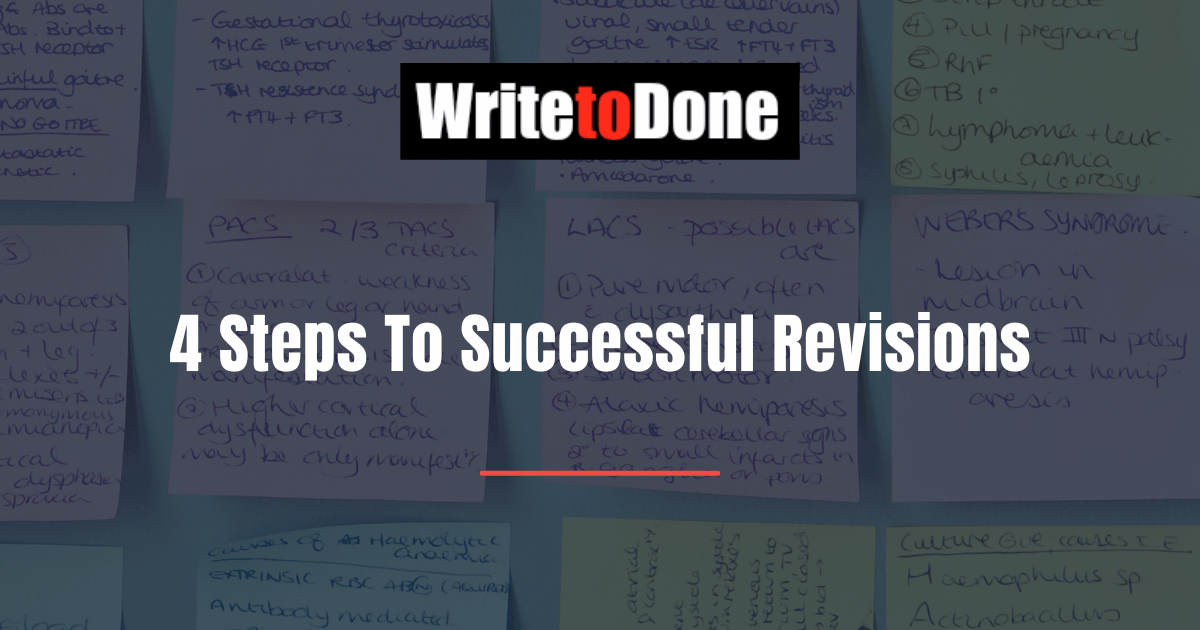Want to be a published author and don’t know how?
Often the difference between a novel that succeeds and a novel that fails is revisions.
I’ve worked with clients that have finished a draft, only to get overwhelmed trying to turn their rough manuscript into a polished, publishable novel. Other writers get demoralized and confused as they get vague rejections from agents and editors, with no direction on how to address the issues raised.
Here are four steps to effectively – and successfully – revise your novel to be a published author.
1. Have a game plan
When writers struggle with revisions, they are usually trying to accomplish too much at once.
They buff a scene to a mirror shine only to cut it later because it doesn’t work in the overall story. Or they bounce from scene to scene, changing a character here, a sentence there, slowly losing all sense of perspective and direction. Either way, they waste time and energy, and often lose momentum.
The solution to this: stick to a three-pass system.
- The first pass is story-level.
- The second pass is scene-level.
- The third pass is sentence-level.
2. Revise for story
All story flows from character. Before anything else, ensure that your protagonist has a solid, working character arc.
How do you do this? By asking the following questions:
- What does he want? What is the reader rooting for?
- Why is what he wants important? Why does he need it now?
- What’s stopping him?
- How has he changed at the end of the book, as a result of these challenges?
- And most importantly: why will a reader care?
Strengthen your characters.
Make sure that your protagonist is a three dimensional person. Readers engage with fully fleshed out characters, not themes hung on archetypes (or worse, stereotypes).
Make sure that the character behaves believably and consistently. Build the plot points from your character – or, if you’re wedded to a plot twist, ensure that the character is developed to organically support the choices you want him to make.
From there, map out your character’s arc via his plot points. (If you have more than one protagonist, you’ll have more than one set of plot points that need to be woven together.)
Strengthen your conflict.
Once you’ve identified the spine of the story, check your conflict.
- Are the obstacles to your protagonist’s goal big enough?
- Are they scalable?
- Does the conflict gradually and inevitably escalate throughout the novel?
- Does your story climax involve the most powerful conflict possible, in terms of story goal?
I find that most writers pull their punches in the third act. A powerful conclusion, where your protagonist faces a truly immense ‘black moment’, can be the difference between a contract and a rejection – or a good review and a return.
An example:
A writer is working on a mainstream suspense/thriller. The protagonist is a lawyer who discovers his firm is protecting a serial-killing surgeon client.
In revisiting the character, the writer realizes that the lawyer is stereotypical: we’re not sure why he needs to expose the law firm other than “it’s the right thing to do”. Introducing a more personal element by enriching the character’s backstory – the surgeon is about to kill a child, for example, and the lawyer lost his son a few years ago – makes his motivation stronger.
Also, the writer notices that the lawyer relies on coincidence and people mentioning the right things at the right moment in order for the surgeon to be brought to justice. Tweaking to make the lawyer more proactive helps fix that… and necessitates more direct conflict, which the writer then escalates.
Finally, the writer sees that the current climax threatens the lawyer with losing his job if he doesn’t play ball. Also, the surgeon has the child’s procedure scheduled in a few days. These are threats, with little urgency or pain attached. The writer then ramps up the third act, actually firing the lawyer and putting the surgeon in the operating room, scalpel in hand.
Each revision creates more layers, strengthens the story structure, and increases both conflict and stakes.
3. Revise for scene strength
Once you’re certain that the story mechanics are in place, we get more granular.
Each scene is a building block to support that overall story arc. The first thing to check on a scene level is: does this scene support my story goal?
From there, you can look at how the scene accomplishes that. Here are a few things to look for:
- Whose point of view is the scene in?
- Are the characters behaving consistently and believably, based on what you know of them?
- Is the dialogue distinct for each character?
- Are you telling, not showing?
- Conversely, are you drowning the reader in too many details that aren’t necessary?
- Is the scene anchored? Is the setting clear? Does it contribute to the tone and feel?
- Is the action descriptive? Is there more than simply “talking heads” in the scene?
An example:
In the serial killing surgeon example, our writer has the following scene opening:
Arnie thought about what had happened. His boss had just told him to bury the paperwork – to shred the patient complaints. Now, he was supposed to shred the police report as well. It was all so suspicious. He was starting to have serious reservations about not only working at Lomax, Jacoby and Randall… he was starting to wonder if their client, Dr. Peterson, wasn’t some kind of monster.
In revising the scene, he notices that it’s telling, not showing, and it feels dead. There’s too much narrative, no anchoring of setting, no action or dialogue, and no description.
So he revises it:
Arnie stood in his boss’s office, dumbfounded. The mahogany desk between them might as well have been a cinderblock wall. “I’m sorry. Are you telling me – you want me to shred all paperwork on Dr. Peterson? Because some of these documents are kind of…”
Arnie bit back on “damning”, the first word that came to mind.
“Suggestive,” he said instead.
Gerald Lomax grimaced. “Don’t be histrionic. The documents don’t have bearing on current cases. We’re simply freeing up file space.”
Arnie cleared his throat, wishing he could loosen the silk tie that felt inexplicably tighter. “But we might…”
Gerald stared at Arnie, his ice blue eyes unblinking. “You’ve been working here for three years, yes? Arnold, was it?”
“Arnie,” he corrected, stammering.
“Well, Arnold – do you want to be a partner here, or not?”
Arnie studied Gerald’s smirk, then glanced down at the document in his hand. He was about to shred a report that implied their client was a murderer.
Suddenly, he wasn’t quite sure how to answer Gerald’s question.
The revision anchors us (Arnie, the lawyer, in his boss’s office.) Instead of narrating what had happened, it puts the reader in scene, experiencing firsthand what Arnie is hearing, seeing, doing. Instead of explaining Arnie’s feelings, the reader is allowed to draw her own conclusions based on his reactions.
4. Polish your prose
You’ve clarified your story arc.
You’ve ensured that each scene works as a part of that larger picture.
Now you’re ready to fine tune the writing itself – the process that most people associate with revising.
A few quick tips:
- Look for repetition. Are you using the same word in close succession? Is there a phrase you’re particularly fond of, or a character action? For example, does your character smile before every dialogue tag?
- Can you strengthen and streamline your prose? Are you using passive voice or filler words?
- If you’re writing first or deep third person POV, does the character’s internal “voice” match his dialogue?
- Are you varying sentence length within a paragraph? Or is it an unrelenting sameness – either a staccato series of short sentences, or a large wall of text?
Beware the usual suspects. Every writer has a favorite sin. I’m addicted to ellipses, for example. Learn what your particular Achilles heel is, and edit for it ruthlessly.
It’s that easy – and that hard.
As they say, revisions are like lifting an engine block: they aren’t exactly complicated, but they aren’t easy.
If you break down your revisions in this order, and ask yourself these questions, you’ll not only avoid feeling overwhelmed, you’ll edit more quickly, more effectively, with more dramatic results. You’ll be closer to your goal of being a published author.
What has been your biggest revising challenge? Please share your experiences – and obstacles – in the comments!

















